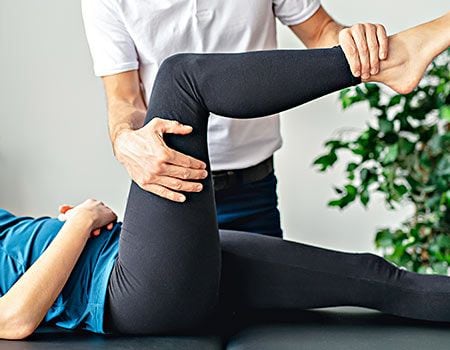
Your chiropractor may recommend stretching and/or strengthening exercises to be performed in the office or at home as part of your treatment and rehabilitation plan. Depending on your problem area(s) and your diagnosis, these exercises may be general stretching and strengthening or more targeted to a certain area. The chiropractor, therapist or chiropractic assistant will work with you to make sure you are comfortable with the exercises and are performing them correctly—and that any questions or concerns are addressed.
Stability
Stability through and across joints and the spinal column is important for protecting nerves and for allowing proper movement of your body. Joint instability causes pain and difficulty moving, and secondarily starts to create pain in other areas. For example, if you had a sprained ankle, you would likely have pain and difficulty walking because the ligaments and possibly some tendons in that ankle have been overstretched and become unstable. When you compensate for your injured ankle, you will likely put increased stress on other joints and muscles, resulting in new aches and pains.
Your chiropractor may not recommend strengthening exercises immediately after an ankle has been sprained, but after some time (maybe a week or more, depending on how severe the sprain is), adding strengthening exercises for the foot, ankle or knee can help create stability across your ankle joint and leg. That stability is important to keep from overstretching the ligaments and spraining the area again.
Stretching exercises can also be used to create stability across and through joints. When muscles, tendons or ligaments are too tight, they can pull on the joints they attach to and cause joint instability. To address this joint instability, chiropractors often look at specific stretching exercises to lengthen tight and short muscles and their attachments to allow the joint to begin to move more freely.
Flexibility
Stretching and strengthening exercises are very important to improve and maintain flexibility. Without flexibility, joints may be under more stress and muscles may be used to support our bodies in ways they were not designed to support us. By adding stretching or strengthening exercises to an area of reduced flexibility, we are able to unload, or take pressure off, joints and muscles so that they can work correctly.
Posture
Many of us spend hours each day sitting at a desk, hunched over a computer, or standing in one position. Over time, these postures can cause pain, and because we are unable to move from a particular sitting or standing position frequently, muscles get stiff and achy, and joints are unable to move well. Adding stretching and strengthening exercises, many of which can be performed during a short break at your desk, will help improve posture and decrease pain that results from poor posture.
Almost everyone can benefit from adding guided stretching and strengthening exercises to their daily routine. Every individual is different; therefore, we can help determine which exercises and stretches are best for you. If you would like to discuss how these exercises may fit into your treatment plan, we are happy to help.
